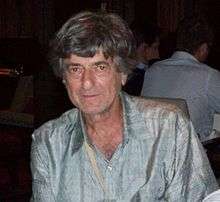Michael Shub
Michael Ira Shub (born August 17, 1943) is an American mathematician who has done research into Dynamical Systems and the Complexity of Real Number Algorithms.
Michael Shub | |
|---|---|
 Michael Shub in April 2012 | |
| Born | Michael Ira Shub August 17, 1943 |
| Nationality | USA |
| Alma mater | University of California, Berkeley |
| Known for | Blum Blum Shub pseudorandom number generator |
| Scientific career | |
| Fields | Mathematics |
| Institutions | Brandeis University University of California, Santa Cruz Queens College at the City University of New York Thomas J. Watson Research Center University of Toronto University of Buenos Aires |
Biography
Shub obtained his Ph.D. degree at the University of California, Berkeley with a thesis entitled Endomorphisms of Compact Differentiable Manifolds on 1967. His advisor was Stephen Smale.[1] From 1967 to 1985 he worked at Brandeis University, the University of California, Santa Cruz and the Queens College at the City University of New York. From 1985 to 2004 he joined IBM's Thomas J. Watson Research Center. From 2004 to 2010 he worked at the University of Toronto. After 2010 he is a researcher at the University of Buenos Aires and at the City University of New York.
Shub was the Chair of the Society for the Foundations of Computational Mathematics from 1995 to 1997. In 2012, a conference From Dynamics to Complexity was organised at the Fields Institute in Toronto celebrating his work.[2]
In 2015 he was elected as a fellow of the American Mathematical Society "for contributions to smooth dynamics and to complexity theory."[3]
Since August, 2016 he is Martin and Michele Cohen Professor and Chair of the Mathematics Department at City College of New York.
Work
Shub has produced publications in dynamical systems and in the complexity of real number algorithms. In his Ph.D. in 1967 he introduced the notion of expanding maps, which gave the first examples of structurally stable strange attractors. In 1974 he proposed the Entropy Conjecture, an important open problem in Dynamical Systems, which was proved by Yosef Yomdin for mappings in 1987.[4] This same year Michael Shub published his book Global Stability of Dynamical Systems, which is often used as a reference in introductory and advanced books on the subject of Dynamical Systems.[5][6][7] He described jointly with Lenore and Manuel Blum a simple, unpredictable, secure random number generator, see Blum Blum Shub. This random generator is useful from theoretical and practical perspectives, see.[8] In 1989 he proposed with Lenore Blum and Stephen Smale the notion of Blum–Shub–Smale machine, an alternative to the classical Turing model of computation. Their model is used to analyse the computability of functions.[9] In 1993, Shub and Smale initiated a rigorous analysis of homotopy-based algorithms for solving systems of nonlinear algebraic equations which has inspired much of the work in that area during the last two decades.[10] Shub was one of the founders of the nonprofit association Foundations of Computational Mathematics, and editor of their journal Foundations of Computational Mathematics with the same name until 2009.
Selected publications
- Blum, Lenore; Blum, Manuel; Shub, Michael (1 May 1986). "A Simple Unpredictable Pseudo-Random Number Generator". SIAM Journal on Computing. 15 (2): 364–383. doi:10.1137/0215025.
- Shub, Michael (1974). "Dynamical systems, filtrations and entropy" (PDF). Bulletin of the American Mathematical Society. 80: 27–41. doi:10.1090/S0002-9904-1974-13344-6.
- Michael Shub, Global Stability of Dynamical Systems, Springer-Verlag: New York, Heidelberg, Berlin, 1987.[11]
- Lenore Blum, Michael Shub, and Stephen Smale, On a theory of computation and complexity over the real numbers: NP-completeness, recursive functions and universal machines, Bulletin of the American Mathematical Society, July 1989.
- Shub, Michael; Smale, Stephen (1993), "Complexity of Bézout's Theorem I: Geometric Aspects", Journal of the American Mathematical Society, 6 (2): 459–501, doi:10.2307/2152805, JSTOR 2152805
- Lenore Blum, Felipe Cucker, Michael Shub, and Stephen Smale, Complexity and Real Computation Springer-Verlag: New York, Heidelberg, Berlin, 1997.
References
- Michael Ira Shub at the Mathematics Genealogy Project
- From Dynamics to Complexity - A conference celebrating the work of Shub
- 2016 Class of the Fellows of the AMS, American Mathematical Society, retrieved 2015-11-16.
- Yomdin, Yosef (1987). "Volume growth and entropy". Israel Journal of Mathematics. 57 (3): 285–300. doi:10.1007/BF02766215.
- Devaney, Robert L. (1992). A first course in chaotic dynamical systems. Westview Press.
- Wiggins, S. Introduction to applied nonlinear systems and chaos, Springer, 1990.
- Hasselblatt, B. and Katok, A. Handbook of dynamical systems, Vol I, Elsevier, 2002.
- Stinson, D. Cryptography: Theory and Practice, Third Edition, Taylor and Francis, 2005
- Gradel, E. Finite Model Theory and Its Applications, Springer-Verlag, 2007
- Bürgisser, P. and Cucker, F.Condition: The Geometry of Numerical Algorithms, Springer, 2013
- Robbin, Joel (1988). "Review: Global stability of dynamical systems by Michael Shub" (PDF). Bull. Amer. Math. Soc. (N.S.). 18 (2): 248–250. doi:10.1090/s0273-0979-1988-15665-0.
External links
- Personal website at the City College of New York.